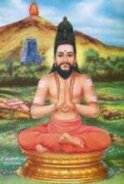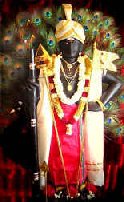

திரு அருணகிரிநாதர் அருளிய
திருப்புகழ்
Sri AruNagirinAthar's
Thiruppugazh

 |  திரு அருணகிரிநாதர் அருளிய Sri AruNagirinAthar's |  |
|---|
| திருப்புகழ் 511 மதிய மண்குண (சிதம்பரம்) Thiruppugazh 511 madhiyamaNguNa (chidhambaram) |
 |  | தமிழிலும் ஆங்கிலத்திலும் பொருள் எழுதியது ஸ்ரீ கோபால சுந்தரம் Meanings in Tamil and English by Sri Gopala Sundaram | English in PDF PDF அமைப்பு | ஆலய வரிசை அகரவரிசை எண்வரிசை தேடல் venue list alphabetical numerical search |
|
தனன தந்தன தந்த தானன தனன தந்தன தந்த தானன தனன தந்தன தந்த தானன ...... தந்ததான ......... பாடல் ......... மதிய மண்குண மஞ்சு நால்முக நகர முன்கலை கங்கை நால்குண மகர முன்சிக ரங்கி மூணிடை ...... தங்குகோண மதன முன்தரி சண்ட மாருத மிருகு ணம்பெறி லஞ்செ லோர்தெரு வகர மிஞ்சிய கன்ப டாகமொ ...... ரொன்றுசேருங் கதிர டங்கிய அண்ட கோளகை யகர நின்றிடும் ரண்டு கால்மிசை ககன மின்சுழி ரண்டு கால்பரி ...... கந்துபாயுங் கருணை யிந்திரி யங்கள் சோதிய அருண சந்திர மண்ட லீகரர் கதிகொள் யந்திர விந்து நாதமொ ...... டென்றுசேர்வேன் அதிர பம்பைகள் டங்கு டாடிக முதிர அண்டமொ டைந்து பேரிகை டகுட டண்டட தொந்த தோதக ...... என்றுதாளம் அதிக விஞ்சையர் தும்ப்ரு நார்தரோ டிதவி தம்பெறு சிந்து பாடிட அமரர் துந்துமி சங்கு தாரைகள் ...... பொங்கவூடு உதிர மண்டல மெங்கு மாயொளி யெழகு மண்டியெ ழுந்து சூரரை உயர்ந ரம்பொடெ லும்பு மாமுடி ...... சிந்திவீழ உறுசி னங்கொடெ திர்ந்த சேவக மழைபு குந்துய ரண்டம் வாழ்வுற வுரக னும்புலி கண்ட வூர்மகிழ் ...... தம்பிரானே. ......... சொல் விளக்கம் ......... மதியம் மண் குணம் அஞ்சு நால் முக(ம்) நகர(ம்) முன்கலை ... சந்திரனது உதவியைக் கொள்ளும் மண்ணின் குணம் ஐந்தாகும்.*1 (அந்த மண்ணுலகம்) நாற் கோண வடிவைக் கொண்டது. (பஞ்சாட்சரத்தில்) ந என்னும் எழுத்தையும், (பஞ்ச*2 கலைகளில்) முன் கலையான நிவர்த்தி கலையையும் கொண்டது. கங்கை நால் குண(ம்) மகரம் ... நீர் (அப்பு மண்டலம்) நான்கு*3 குணம் கொண்டது. இது பஞ்சாட்சரத்தில் ம என்னும் எழுத்தைக் குறிக்கும். முன் சிகர(ம்) அங்கி மூணிடை தங்கு கோண(ம்) ... அப்பு மண்டலத்துக்கு முன் உள்ள அக்கினி மண்டலம் பஞ்சாட்சரத்தில் சி என்னும் எழுத்தைக் குறிக்கும். (இந்த அக்கினி மண்டலம்) மூன்று*4 குணமும் முக்கோணமும் கொண்டது. மதனம் முன் தரி சண்ட மாருதம் இரு குணம் பெறில் அஞ்சு எல் ஓர் தெரு வகரம் ... அழித்தல் தன்மையை தன்னிடத்தே கொண்டுள்ள பெருங் காற்று (வாயு மண்டலம்) இரண்டு*5 குணங்களைப் பெற்றதாய், ஐந்துடன் ஒன்று சேர்கின்ற (ஆறு) ஒளி பொருந்திய வீதியாகும். (அதாவது வாயு மண்டலம் ஆறு கோண வடிவானது). பஞ்சாட்சரத்தில் உள்ள வா என்னும் எழுத்தைக் குறிக்கும். மிஞ்சி அகன் படா கம் ஒர் ஒன்று சேரும் கதிர் அடங்கிய அண்ட கோளகை யகர(ம்) நின்றிடும் ... விரிந்துள்ள ஆகாயம் ஒப்பற்ற ஒன்று சேரும் குணத்தை (சப்தத்தைக்) கொண்டதாகும். (இந்த ஆகாய மண்டலம்) சூரிய சந்திரர் அடங்கி விளங்குவதான அண்ட உருண்டையான வட்ட வடிவம் கொண்டது. இதை ய என்னும் எழுத்து நின்று விளக்கும். (இ)ரண்டு கால் மிசை ககன(ம்) மின் சுழி (இ)ரண்டு கால் பரி கந்து பாயும் ... (ரேசகம், பூரகம் என்னும்) இரண்டு வழி கொண்டு அண்டமாகிய ஒளி கொண்ட உச்சியில் (கபாலத்தில்) இடை கலை, பிங்கலை*6 என்னும் நடையுள்ள குதிரைகள் பாய்ந்து செல்வன ஆகும். கருணை இந்திரியங்கள் சோதிய அருண சந்திர மண்டலீகரர் கதி கொள் யந்திர விந்து நாதமொடு என்று சேர்வேன் ... (அவைகளை வசப்படுத்த) இந்திரியங்களின் அருள் ஜோதி விளங்க, சூரிய மண்டலம், சந்திர மண்டலம், அக்கினி மண்டலம் ஆகிய மும் மண்டலங்களில் பொருந்தியுள்ள மூர்த்திகள் பிரசன்னமாகும் மந்திர சக்தியால் லிங்கவடிவ சிவத்துடன் நான் என்று சேர்வேன்? அதிர பம்பைகள் டங்கு டாடிக முதிர அண்டமொடு ஐந்து பேரிகை டகுட டண்டட தொந்ததோதக என்று தாளம் அதிக ... ஒலிக்கும் பறைகள் டங்கு டாடிக என்ற பேரொலியை முற்றின வகையில் எழுப்ப, அண்டங்களில் ஐந்து வகையான பேரிகை (தோற்கருவி, துளைக் கருவி, நரம்புக் கருவி, கஞ்சக்கருவி, மிடற்றுக் கருவி என்னும் ஐவகை வாத்தியங்கள்) டகுட டண்டட தொந்த தோதக என்று தாளம் மிக்கு ஒலிக்க, விஞ்சையர் தும்ப்ரு நார்தரொடு இத விதம் பெறு சிந்து பாடிட அமரர் துந்துமி சங்கு தாரைகள் பொங்க ஊடு ... பதினெண்கணங்களுள் ஒருவராகிய வித்தியாதரர், தும்புரு நாரதர் என்பவர்களுடன் இன்பகரமான முறையில் சிந்து முதலிய இசை வகையைப் பாட, தேவர்கள் தேவபேரிகை, சங்கம், தாரைகள் (நீண்ட ஊதுங் குழல்கள்) இவைகளை முழக்கி அவ்வொலி இடையே மேலெழுந்து பொங்க, உதிர மண்டலம் எங்குமாய் ஒளி எழ குமண்டி எழுந்து சூரரை உயர் நரம்பொடு எலும்பு மா முடி சிந்தி வீழ உறு சினம் கொண்டு எதிர்த்த சேவக ... இரத்தப் பெருக்கின் வெள்ளம் எல்லாவிடத்தும் பரவ, தீயின் ஒளி வீச, குதித்து எழுந்து போருக்கு வந்த சூரர்களை (அவர்களுடைய) பெரிய நரம்புகளுடன், எலும்புகளும் மாமுடிகளும் சிதறுண்டு விழும்படியாக கோபத்துடன் எதிர்த்துப் போர் புரிந்த வலிமையாளனே, மழை புகுந்து உயர் அண்டம் வாழ்வுற உரகனும் புலி கண்ட ஊர் மகிழ் தம்பிரானே. ... மழை பெய்து உயர்ந்த இப்பூமியில் உள்ளோர் வாழ்வுறும்படி, பாம்பு உருவராகிய பதஞ்சலியும், புலி உருவரான வியாக்ரபாதரும் (இறைவன் நடனத்தைத்) தரிசித்த தலமாகிய சிதம்பரத்தில் மகிழ்ந்து வீற்றிருக்கும் தம்பிரானே. |
*1 - மண்ணின் ஐந்து குணங்கள்: சுவை, ஒளி, ஊறு, ஓசை, நாற்றம். |
*2 - ஐந்து கலைகள்: நிவிர்த்திகலை - ஆன்மாக்களை பாசத்தினின்று விடுவிப்பது. பிரதிஷ்டாகலை - ஆன்மாக்களை முக்தியில் உய்ப்பது. வித்யாகலை - பந்தநிலை நீங்கிய ஆன்மாக்களுக்கு அனுபவ ஞானத்தைத் தருவது. சாந்திகலை - ஆன்மாக்களுக்கு எல்லாத் துன்பங்களும் சாந்தமாகச் செய்வது. சாந்தியதீதகலை - சாந்தி பெற்ற ஆன்மாக்களுக்குத் துன்பங்களை முற்றும் ஒழியச் செய்வது. |
*3 - நீரின் நான்கு குணங்கள்: சப்தம், பரிசம், உருவம், ரஸம். |
*4 - தீயின் முக்குணங்கள்: சப்தம், பரிசம், உருவம். |
*5 - வாயுவின் இரண்டு குணங்கள்: சப்தம், பரிசம். |
*6 - இங்கு சிவயோக முறைகள் விளக்கப்பட்டுள்ளன. அதன் சுருக்கம் வருமாறு: நாம் உள்ளுக்கு இழுக்கும் காற்றுக்குப் 'பூரகம்' என்றும், வெளிவிடும் காற்றுக்கு 'ரேசகம்' என்றும் பெயர். உள்ளே நிறுத்திவைக்கப்படும் காற்றுக்கு 'கும்பகம்' என்று பெயர். உட் கொள்ளும் பிராணவாயு உடலில் குறிப்பிட்ட 'ஆதாரங்கள்' (நிலைகள், சக்கரங்கள்) மூலமாகப் படிப்படியாகப் பரவி, மேல் நோக்கிச் சென்று, தலையில் 'பிரம கபால'த்தில் உள்ள 'ஸஹஸ்ராரம்' (பிந்து சக்கரம்) என்ற சக்கரத்துக்குச் செல்லும். இந்த ஐக்கியம் ஏற்படும்போது, அமுத சக்தி பிறந்து, ஆறு ஆதாரங்களுக்கும் ஊட்டப்பட்டு, மீண்டும் அதே வழியில் 'மூலாதார'த்தை வந்து அடையும். இந்த ஆதாரங்களை ஒழுங்கு படுத்தும் வகையில் மூன்று 'மண்டல'ங்களும் (அக்கினி, ஆதித்த, சந்திர மண்டலங்கள்), பத்து 'நாடி'களும் (இடைகலை, பிங்கலை, சுழுமுனை முதலியன) உள்ளன. 'இடைகலை' பத்து நாடிகளுள் ஒன்று. இடது நாசியால் விடும் சுவாசம். 'பிங்கலை' பத்து நாடிகளுள் ஒன்று. வலது நாசி வழியால் விடும் சுவாசம். 'சுழு முனை' இடைகலைக்கும் பிங்கலைக்கும் இடையில் உள்ளது. 'சுழு முனை' ஆதாரம் ஆறிலும் ஊடுருவி நிற்பது. 'இடைகலை'யும், 'பிங்கலை'யும் ஒன்றுக்கொன்று பின்னி நிற்பன. சுவாச நடப்பை 'ப்ராணாயாமம்' என்ற யோக வன்மையால் கட்டுப்படுத்தினால் மன அமைதி ஏற்படும். |
ஆதாரங்களின் பெயர்களும், உடலில் இருக்கும் இடம், உரிய ஐம்பூதங்கள், அனுட்டிக்கும்போது மலர் வடிவங்களின் அமைப்பு, அக்ஷரக் குறிப்பு ஆகியவை கீழே தரப்பட்டுள்ளன. மேலும் இந்த ஆதாரங்களுக்கு உரிய தலங்கள், கடவுளர்கள் பெயர்களும் கொடுக்கப்பட்டுள்ளன. | ||||||
| ஆதாரம் மூலாதாரம் சுவாதிஷ்டானம் மணிபூரகம் அநாகதம் விசுத்தி ஆக்ஞா பிந்து சக்கரம் (துவாதசாந்தம், ஸஹஸ்ராரம், பிரமரந்திரம்) | இடம் குதம் கொப்பூழ் மேல்வயிறு இருதயம் கண்டம் புருவத்தின் நடு கபாலத்தின் மேலே | பூதம் மண் அக்கினி நீர் காற்று ஆகாயம் மனம் | வடிவம் 4 இதழ் கமலம் முக்கோணம் 6 இதழ் கமலம் லிங்கபீடம் நாற் சதுரம் 10 இதழ் கமலம் பெட்டிப்பாம்பு நடு வட்டம் 12 இதழ் கமலம் முக்கோணம் கமல வட்டம் 16 இதழ் கமலம் ஆறு கோணம் நடு வட்டம் 3 இதழ் கமலம் 1008 இதழ் கமலம் | அக்ஷரம் ஓம் ந(கரம்) ம(கரம்) சி(கரம்) வ(கரம்) ய(கரம்) | தலம் திருவாரூர் திருவானைக்கா திரு(வ) அண்ணாமலை சிதம்பரம் திருக்காளத்தி காசி (வாரணாசி) திருக்கயிலை | கடவுள் விநாயகர் பிரமன் திருமால் ருத்திரன் மகேசுரன் சதாசிவன் சிவ . சக்தி ஐக்கியம் |
| 'wikisource' reference links for this song இப்பாடலுக்கான 'விக்கிமூலம்' இணையப் பக்கங்கள் pg 2.533 pg 2.534 pg 2.535 pg 2.536 pg 2.537 pg 2.538 pg 2.555 WIKI_urai Song number: 652 goto wiki alpha list (Please note: Kaumaram.com is NOT responsible for accuracy and contents of external links) |
| மன்னிக்கவும், இப்பாடலுக்கு ஒலிப்பதிவுகள் இல்லை Sorry, no audio recordings for this song |
|
Song 511 - madhiya maNguNa (chidhambaram) thanana thanthana thantha thAnana thanana thanthana thantha thAnana thanana thanthana thantha thAnana ...... thanthathAna ......... Song ......... mathiya maNkuNa manju nAlmuka nakara munkalai kangai nAlkuNa makara munsika rangi mUNidai ...... thangukONa mathana munthari saNda mArutha miruku NampeRi lanje lErtheru vakara minjiya kanpa dAkamo ...... ronRusErung kathira dangiya aNda kOLakai yakara ninRidum raNdu kAlmisai kakana minsuzhi raNdu kAlpari ...... kanthupAyung karuNai yinthiri yangaL sOthiya aruNa santhira maNda leekarar kathikoL yanthira vinthu nAthamo ...... denRusErvEn athira pampaikaL dangu dAdika muthira aNdamo dainthu pErikai dakuda daNdada thontha thOthaka ...... enRuthALam athika vinjaiyar thumpru nArtharO dithavi thampeRu sinthu pAdida amarar thunthumi sangu thAraikaL ...... pongavUdu uthira maNdala mengu mAyoLi yezhaku maNdiye zhunthu cUrarai uyarna rampode lumpu mAmudi ...... sinthiveezha uRusi nangode thirntha sEvaka mazhaipu kunthuya raNdam vAzhvuRa vuraka numpuli kaNda vUrmakizh ...... thambirAnE. ......... Meaning ......... mathiyam maN kuNam anju nAl muka(m) nakara mun kalai: The earth, that is benefited by the moon, has five*1 characteristics. That earth is of the shape of a quadrilateral. It assumes the first letter "na" in the five sacred letters (NamasivAya) and takes after the nivarththikalai of the five*2 kalais. kangai nAl kuNa(m) makaram: The zone of water has four*3 characteristics. It denotes the letter "ma" in the PanchAkshara ManthrA (NamasivAya). mun sikara(m) angi mUNidai thangu kONa(m): The zone ahead of that of water is fire which refers to the letter "si" in NamasivAya. This fire zone has three*4 characteristics and is of the shape of a triangle. mathanam mun thari saNda mArutham iru kuNam peRil anju el Or theru vakaram: The huge zone of air with the inherent quality of destruction has two*5 characteristics. It is the effulgent avenue where five elements are joined by the sixth unique one making the air zone a hexagon, symbolising the letter "vA" in NamasivAya. minji akan padA kam or onRu sErum kathir adangiya aNda kOLakai yakara(m) ninRidum: The wide open sky (cosmos) is the zone with a unique characteristic (namely sound) and is of an elliptic shape where the bright sun and the moon are contained. This zone is denoted by the letter "ya" in NamasivAya. (i)raNdu kAl misai kakana(m) min suzhi (i)raNdu kAl pari kanthu pAyum: In a two way path (consisting of REsakam and PUrakam) on the brilliant skull, the horses with two unique gaits called idakalai and pingalai*6 gallop. karuNai inthiriyangaL sOthiya aruNa santhira maNdalIkarar kathi koL yanthira vinthu nAthamodu enRu sErvEn: (In order to rein those horses and) to spread the gracious rays all over my limbs, I need to acquire the mystical power to be bestowed on me by all the deities that manifest in the zones of the Sun, the Moon and Fire; when will I join the great SivA in the form of Lingam (Nadham - Sound)? athira pampaikaL dangu dAdika muthira aNdamodu ainthu pErikai dakuda daNdada thonthathOthaka enRu thALam athika: The reverbrating drums made noise at a high decibel level to the beats "dangu dAdika"; the five types of percussion instruments of this world (namely, leather instruments, reeds with holes, string instruments, blowers - from the throat, and cymbals) were beaten loudly to the meter "dakuda daNdada thonthathOthaka"; vinjaiyar thumpru nArtharodu itha vitham peRu sinthu pAdida amarar thunthumi sangu thAraikaL ponga Udu: VidhyAdharAs, one of the eighteen classes of sivagaNAs, along with Thumpuru and NAradhar blissfully sang the music of the variety of Sindhu; the celestials played the heavenly drum, blew the conch and the long trumpets, with the resultant noise soaring high; uthira maNdalam engumAy oLi ezha kumaNdi ezhunthu cUrarai uyar narampodu elumpu mA mudi sinthi vIzha uRu sinam koNdu ethirththa sEvaka: the deluge of blood flowing like a flood everywhere and fire burning incessantly all around, the demons leapt to fight on the battlefield, and the huge bunches of their veins and bones were scattered along with their big heads when You confronted them with rage, Oh Mighty One! mazhai pukunthu uyar aNdam vAzhvuRa urakanum puli kaNda Ur makizh thambirAnE.: The people on this world, rendered fertile and prosperous by the downpours of rain, prospered as Lord NatarAjar danced in this shrine at Chidhambaram, which dance was witnessed by Sage Pathanjali, of the form of a serpent, and VyAkrapAthar, of the form of a tiger; and You are seated here with relish, Oh Great One! |
*1 The five characteristics of earth: taste, light, feel, sound and smell. |
*2 The five kalais (purifiers): nivirththikalai - This liberates the souls from bondage. pirathishtAkalai - This enables realisation to the souls. vidhyAkalai - The liberated souls gain wisdom and experience. sAnthikalai - The souls are freed from miseries by converting them to tranquility. sAnthiyatheethakalai - The peaceful souls are totally liberated from miseries. |
*3 The four characteristics of water: taste, light, feel and, sound. |
*4 The three characteristics of fire: sound, feel and light. |
*5 The two characteristics of air: sound and feel. |
*6 In this song, several Siva-yOgA principles are explained: The inhaled air is known as 'pUragam' and the exhaled air is 'rechagam'. The retained air is 'kumbagam'. The oxygen that enters the body climbs up step by step through several centres, known as 'chakrAs' and ultimately reaches 'sahasrAram' or 'bindhuchakram' on the top of the skull. At that point of union, nectar flows from that chakrA and seeps through and soaks the six centres of the body and returns to the basic chakrA, 'mUlAthAram'. Three zones (namely, the sun zone, the moon zone and the fire zone) and ten nerves ('nAdis') govern the six centres; the principal nerves are 'susumna', 'idaikala' and 'pingala'. idakala: one of the ten 'nAdis' (nerves), when inhalation takes place through the left nostril; pingala: one of the ten 'nAdis' (nerves), when inhalation takes place through the right nostril; susumna: one of the ten 'nAdis' (nerves), situated between the above two 'nadis', and running through the spinal chord covering all the six centres of 'kundalini'. ('idakala' and 'pingala' are entwined around 'susumna'). If breathing is controlled through a yOgA called 'praNAyAmA', the mind becomes tranquil. |
The names of the chakrA centres, the deities, the elements, the zones of the body where they are located, the shape of the chakrAs, the description of the flowers in the chakrAs, the letters of the ManthrA governing them and the temple-towns representing them are given in the following chart: | ||||||
| ChakrA mUlAthAram swAthishtAnam maNipUragam anAgatham visudhdhi AgnyA Bindu chakkaram (DhwAdhasAntham, SahasrAram, Brahma-ranthiram) | Body Zone Genitals Belly-button Upper belly Heart Throat Between the eyebrows Over the skull | Element Earth Fire Water Air Sky Mind | Shape 4-petal lotus Triangle 6-petal lotus Lingam Square 10-petal lotus cobra in box central circle 12-petal lotus Triangle lotus circle 16-petal lotus Hexagon central circle 3-petal lotus 1008-petal lotus | Letter Om na ma si va ya | Temple ThiruvArUr ThiruvAnaikkA Thiru aNNAmalai Chidhambaram ThirukkALaththi VaranAsi (kAsi) Mt. KailAsh | Deity VinAyagar BrahmA Vishnu RUdhran MahEswaran SathAsivan Siva-Sakthi Union |
| தமிழில் PDF அமைப்பு ஆலய வரிசை அகரவரிசை எண்வரிசை தேடல் in PDF venue list alphabetical numerical search |
| ... www.kaumaram.com ... The website for Lord Murugan and His Devotees முகப்பு அட்டவணை மேலே தேடல் home contents top search |
If you do not see Tamil characters or for 'offline' viewing, please install 'SaiIndira' fonts from Azhagi.com download Free Azhagi software |
Kaumaram.com is a non-commercial website. This website is a dedication of Love for Lord Murugan. Please take note that Kaumaram.com DOES NOT solicit any funding, DIRECTLY or INDIRECTLY. |